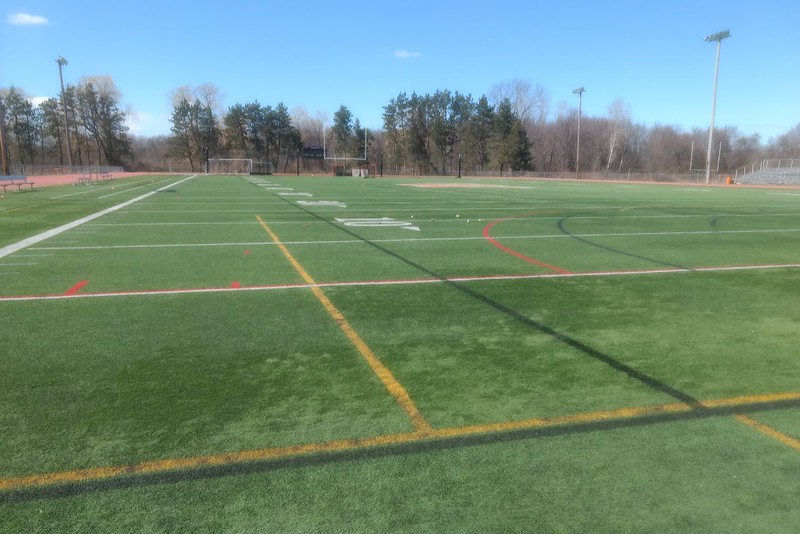Outdoor Facilities: Renovation and Negotiation
Credit: Madeline Maurer
The Wayland town meeting voted overwhelmingly Tuesday to approve renovations to WHS’ athletic facilities.
April 26, 2019
After years of team after team giving their all on WHS’ turf field – not to mention the years of weather damage from storms and burning hot days – the field is long overdue for a replacement. Though it’s carried the victories and losses of Wayland Warriors who have come and gone, the turf is on its last legs. Recognizing this, Wayland’s athletic and recreational departments are planning to start anew with renovated facilities.
Due to the worn-out condition of its outdoor facilities, the Wayland High School Athletic Department and Wayland Town Recreation Department will bring a proposal for two turf field renovation projects to the ballots this April among other renovations to WHS’ outdoor sporting facilities. Voters will decide if this project will be a meaningful contribution to the community, if it’s worth the money and work and, ultimately, if the plan should go through.
The Wayland recreation department first started looking into developing a new town turf field more than five years ago in the early 2010s. Since then, hundreds of hours have been spent over the last four years dedicated to forming a proposal that will satisfy all parties involved.
“There is a facility project that we’ve really been working on for four years,” WHS Athletic Director Heath Rollins said. “It’s going to be up for [a] town vote here in April. In a nutshell, the facility that we have out there is pretty outdated and worn out. [We will be] replacing the track, the bleachers, the turf and swapping the tennis courts and the softball fields to get around some environmental concerns. ”
The first part of the renovation plan would build a new turf field at Loker Conservation, which is entirely separate from Loker Elementary School. Loker Conservation, though in the same area, is a sector of land that has been empty, discluding an abandoned parking lot since the Dow Chemical Company vacated the lot in 2000.
This plan would help alleviate the problems Wayland athletic departments have been suffering due to the town’s field shortage. While neighboring towns to Wayland have on average two or more usable turf fields, Wayland only has one located at the high school. The turf field that Wayland does have is in desperate need of renewal. Having passed its life expectancy in recent years, the field is subpar in terms of optimal, or even safe, conditions.
“The turf is over ten years old, and that’s what their life expectancy is, [around] ten years old,” K-12 Wellness Director Scott Parseghian said. “When they do tests on the turf right now, there aren’t enough rubber palettes left after all the years of digging it up and everything like that. They’re saying it’s almost unsafe and [Wayland has] to update it.”
With the new school start times beginning next year, the recreation department is wary of the repercussions of too few available turf fields. Because high school sports teams wouldn’t be done using facilities such as the track and turf field, younger students in Wayland wouldn’t be permitted to hold their own practices on the premises until around an estimated 8 p.m.
Not only would young students not get on the fields until late in the evening, but the recreation department may be forced to turn away kids who want to participate in team sports simply because Wayland does not have the field capacity to support Wayland’s youth.
Passing the proposal for the Loker field would also mean new opportunities for adult and senior sports leagues in Wayland. Currently, many adult and senior leagues have to rent field space from other towns because Wayland does not have space available to offer the older members of Wayland’s community.
Although the renovations would benefit the athletic programs across Wayland, not everyone is totally on board with the idea. Many people have concerns ranging from the effects on the environment to the increase in the town’s taxes. This project is a major undertaking for the entire town, so the majority needs to be convinced that it will benefit the community.
The biggest hurdle thus far has been convincing Wayland’s conservation committee that the turf projects
will not be detrimental to the surrounding environment. Since the back corner of the turf is located on a piece of conservation land, local environmentalists have expressed concerns about the field’s position. In an attempt to address this issue, the renovation plan includes moving the field out of this piece of land.
“The back right-hand corner is hitting a piece of conservation land, so they’re actually going to move the turf field out of there and about 50 yards towards the school,” Parseghian said. “The turf is actually going to be almost right to the driveway, that will get it out of the conservation. It’s not much [that’s in the conservation], but we’re going to move the field so it’s not in the conservation area.”
In addition to the property stretching onto a piece of conservation land, environmentalists are also concerned about the state of the water in the area. The field is right by the Sudbury River, which accounts for around 8% of Wayland’s water supply. If contaminants from the field enter the water, the local water supply will run into issues. Luckily, when tested, the water showed to be uncontaminated by the materials of the turf.
“I think we do have some environmental challenges here on the facility because we do have the Sudbury River that runs right up behind the field, and we do have town drinking wells that [make up for] I think 8% of the water for Wayland on the facility,” Rollins said. “[We’re] trying to make sure that it’s safe and appropriate to use.”
Environmental concerns are not the only factor that’s causing local concern. Renovation costs money, and that money has to come from somewhere. In the case of the athletic renewals, as with any public renovations, the money will have to come from citizen’s taxes, and this one isn’t cheap. Allegedly, the total cost of this project would be around $10 million between the WHS and Loker renovations. For this cost to be covered, the average household in Wayland would have to increase the amount of taxes they pay by $50 to $100 per year for five years. Unsurprisingly, this tax increase isn’t very appealing to the taxpayers who are unaffected by the state of the field.
“It is the taxpayers’ and the town’s money,” Rollins said. “I think the proposal is going to tell the average household what their cost of the field would be. It’s going to be somewhere in the $50 to $100 a year range for every house in Wayland for five years to get it done, so heads up to the people that decide what they want.”
Despite the cost, the athletic department still believes in the value of following through with the proposed plans. Given the number of facilities that need updating or installation, the price tag can be seen as justifiable.
Other problems the rec department faced while planning their Loker turf field proposal were complaints that it would increase traffic in the area and that the lights installed on the Loker property would impede on nearby residences.
The recreation department answered these questions by conducting a comprehensive traffic study which concluded that traffic would not have a significant effect in the area, and a study on the lights determined they would not bleed onto Rice Road or surrounding areas.
The rec department said that new technology allows for the light to be concentrated on the field without disturbing the local neighborhoods.
For the plans to be into motion, three steps need to be completed: the conservation committee has to issue a permit, which the rec department says they expect to obtain at this point without a problem. Even if the conservation committee surprised recreation department members and denied their request, the recreation department and high school athletics department would deliver an appeal which would ultimately allow for them to go forth. Second, they need a permit from the zoning department, which they again expect to get without hindrance. Third, voters would have to approve the plan through a ballot on April 23. Finally, Wayland residents would approve the budget during the town meeting on April 30.
The voting has the potential to result in four different outcomes: Wayland residents could reject both proposals, accept both, accept the Loker proposal and not the high school plan or the high school plan and not the Loker proposal.
The recreation department and high school athletic department remain hopeful that their years of effort will pay off and that in 12 months, WHS and the town of Wayland will be sporting brand new turf fields.
“It’ll set up the school well for a large number of years,” Rollins said. “If we build it right, it’s a long-term investment, not just for the next couple years. It will hold up well long-term.”





![Last Wednesday, the Wayland School Committee gathered to discuss a number of topics regarding the health curriculum and Innovation Career Pathway course. Another large topic of conversation was the ways to potentially mitigate distracting cell phone usage. "These [phones] are going to distract your learning and social relationships," Superintendent David Fleishman said. "That's concrete right there."](https://waylandstudentpress.com/wp-content/uploads/2025/06/Screenshot-2025-06-04-at-9.49.31 PM-1200x886.png)



























![Troy Hoyt finishes the Boston Marathon, running for the Hoyt Foundation. T. Hoyt is the son of Hoyt Foundation CEO Russ Hoyt.
“[Running a marathon] might seem like a big thing, when it’s presented to you at first, but if you break it up and just keep telling yourself, “Yes, you can,” you can start chipping away at it. And before you know it, you’ll be running the whole 26 miles, and you won’t even think twice about it.” T. Hoyt said.](https://waylandstudentpress.com/wp-content/uploads/2025/04/C36E8761-1CBB-452E-9DF2-543EF7B1095E_1_105_c.jpeg)














































